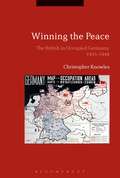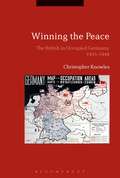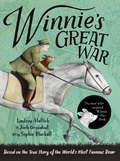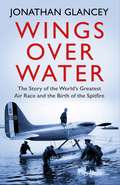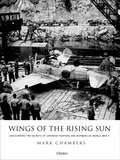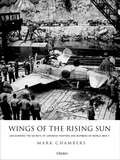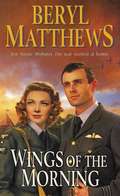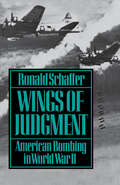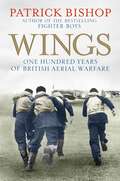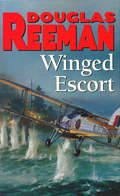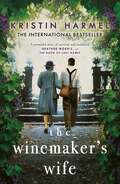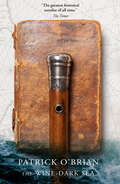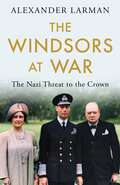- Table View
- List View
Winning the Peace: The British in Occupied Germany, 1945-1948
by Christopher KnowlesBy adopting a unique biographical approach, this book examines the aims and intentions of twelve important and influential individuals who worked for the British Military Government in occupied Germany during the first three years after the end of the Second World War. British policy was distinctive, and the British zone was the largest and economically most important of all four zones. Although the three Western Allies all ended in the same place with the creation of an independent Federal Republic of (West) Germany in 1949, they took different paths to get there. The role of the British has been much misunderstood. Winning the Peace strikes a balance between earlier self-congratulatory accounts of the British occupation, and the later more critical historiography. It highlights diversity of aims and personal backgrounds and in so doing explains some of the complexities and apparent contradictions in British occupation policy. The book concludes that, despite diversity among those studied, all twelve individuals followed a policy described as the 'three Rs' - Reconstruction, Renewal and Reconciliation - rather than the 'four Ds' - De-militarisation, De-nazification, De-industrialisation, and Democratisation - highlighted in earlier histories of the occupation. Whilst reflecting on the role of human agency, Christopher Knowles examines why individuals sometimes failed to achieve what they originally intended, and how their aims and perceptions changed over time to reveal broader political, sociological and cultural forces, outside their direct control. This book is an innovative study for those interested in the Allied occupation, the post-war history of Germany and the study of military occupation generally.
Winning the Peace: The British in Occupied Germany, 1945-1948
by Christopher KnowlesBy adopting a unique biographical approach, this book examines the aims and intentions of twelve important and influential individuals who worked for the British Military Government in occupied Germany during the first three years after the end of the Second World War. British policy was distinctive, and the British zone was the largest and economically most important of all four zones. Although the three Western Allies all ended in the same place with the creation of an independent Federal Republic of (West) Germany in 1949, they took different paths to get there. The role of the British has been much misunderstood. Winning the Peace strikes a balance between earlier self-congratulatory accounts of the British occupation, and the later more critical historiography. It highlights diversity of aims and personal backgrounds and in so doing explains some of the complexities and apparent contradictions in British occupation policy. The book concludes that, despite diversity among those studied, all twelve individuals followed a policy described as the 'three Rs' - Reconstruction, Renewal and Reconciliation - rather than the 'four Ds' - De-militarisation, De-nazification, De-industrialisation, and Democratisation - highlighted in earlier histories of the occupation. Whilst reflecting on the role of human agency, Christopher Knowles examines why individuals sometimes failed to achieve what they originally intended, and how their aims and perceptions changed over time to reveal broader political, sociological and cultural forces, outside their direct control. This book is an innovative study for those interested in the Allied occupation, the post-war history of Germany and the study of military occupation generally.
Winning the Peace: The Strategic Implications of Military Civic Action
by John W. Pauw George LuzMilitary Civic Action--U.S. troops working on nation-building tasks with troops of another country--is traced from its formal beginning under President Eisenhower and enthusiastic reception under President Kennedy, through its successes and failures during the Vietnam years, to its present status as a strategic tool. Contributing authors debate the future role of Military Civic Action as a way to retain a U.S. military presence around the world, bolster emergent democracies, assist other militaries in their transition to democratic military professionalism, reinforce the humanitarian efforts of USAID and private volunteer organizations, train U.S. units for worldwide flexible missions, and protect the world from environmental degradation and the scourge of drug abuse. Although this volume draws on the history of U.S. Military Civic Action around the world, special emphasis is placed on Latin America as the ideal focus for Military Civic Action during the 1990s.The authors argue that Military Civic Action is among the most cost effective ways of achieving U.S. strategic objectives while retaining and justifying the expense of a skilled, professional U.S. military force. Military Civic Action incorporates some of the deepest-held U.S. values and is a tool that can win the support of liberals and conservatives alike. Nonetheless, in order for it to be successful, Military Civic Action must be integrated into a fully articulated national strategy in which the Congress, the President, and the appropriate federal bureaucracies have reached consensus. This book will be of interest to military professionals and political scientists interested in foreign and defense policy.
Winning the Battle to Lose the War?: Brazilian Electronics Policy Under US Threat of Sanctions
by Maria-Ines BastosA US/Brazil trade conflict on the Brazilian protectionist electronics policy developed during 198589. In that period and under the threat of trade sanctions, a few changes were made in the Brazilian policy. Major consequences of the conflict were felt after its conclusion. It was one important political factor among the forces that pushed for the opening of the Brazilian electronics market in the early 1990s.
Winning the Battle to Lose the War?: Brazilian Electronics Policy Under US Threat of Sanctions
by Maria-Ines BastosA US/Brazil trade conflict on the Brazilian protectionist electronics policy developed during 198589. In that period and under the threat of trade sanctions, a few changes were made in the Brazilian policy. Major consequences of the conflict were felt after its conclusion. It was one important political factor among the forces that pushed for the opening of the Brazilian electronics market in the early 1990s.
Winning Independence: The Decisive Years of the Revolutionary War, 1778-1781
by John FerlingFrom celebrated historian John Ferling, the underexplored history of the second half of the Revolutionary War, when, after years of fighting, American independence often seemed beyond reach. It was 1778, and the recent American victory at Saratoga had netted the U.S a powerful ally in France. Many, including General George Washington, presumed France's entrance into the war meant independence was just around the corner. Meanwhile, having lost an entire army at Saratoga, Great Britain pivoted to a “southern strategy.” The army would henceforth seek to regain its southern colonies, Virginia, North Carolina, South Carolina, and Georgia, a highly profitable segment of its pre-war American empire. Deep into 1780 Britain's new approach seemed headed for success as the U.S. economy collapsed and morale on the home front waned. By early 1781, Washington, and others, feared that France would drop out of the war if the Allies failed to score a decisive victory that year. Sir Henry Clinton, commander of Britain's army, thought “the rebellion is near its end.” Washington, who had been so optimistic in 1778, despaired: “I have almost ceased to hope.” Winning Independence is the dramatic story of how and why Great Britain-so close to regaining several southern colonies and rendering the postwar United States a fatally weak nation ultimately failed to win the war. The book explores the choices and decisions made by Clinton and Washington, and others, that ultimately led the French and American allies to clinch the pivotal victory at Yorktown that at long last secured American independence.
Winning and Losing the Nuclear Peace: The Rise, Demise, and Revival of Arms Control
by Michael KreponThe definitive guide to the history of nuclear arms control by a wise eavesdropper and masterful storyteller, Michael Krepon. The greatest unacknowledged diplomatic achievement of the Cold War was the absence of mushroom clouds. Deterrence alone was too dangerous to succeed; it needed arms control to prevent nuclear warfare. So, U.S. and Soviet leaders ventured into the unknown to devise guardrails for nuclear arms control and to treat the Bomb differently than other weapons. Against the odds, they succeeded. Nuclear weapons have not been used in warfare for three quarters of a century. This book is the first in-depth history of how the nuclear peace was won by complementing deterrence with reassurance, and then jeopardized by discarding arms control after the Cold War ended. Winning and Losing the Nuclear Peace tells a remarkable story of high-wire acts of diplomacy, close calls, dogged persistence, and extraordinary success. Michael Krepon brings to life the pitched battles between arms controllers and advocates of nuclear deterrence, the ironic twists and unexpected outcomes from Truman to Trump. What began with a ban on atmospheric testing and a nonproliferation treaty reached its apogee with treaties that mandated deep cuts and corralled "loose nukes" after the Soviet Union imploded. After the Cold War ended, much of this diplomatic accomplishment was cast aside in favor of freedom of action. The nuclear peace is now imperiled by no less than four nuclear-armed rivalries. Arms control needs to be revived and reimagined for Russia and China to prevent nuclear warfare. New guardrails have to be erected. Winning and Losing the Nuclear Peace is an engaging account of how the practice of arms control was built from scratch, how it was torn down, and how it can be rebuilt.
Winnie's Great War: The remarkable story of a brave bear cub in World War One
by Lindsay Mattick Josh GreenhutEveryone has heard of Winnie-the-Pooh, but not everyone knows about the real Canadian bear who lent him her name. This is a wonderful tale of courage and friendship, for fans of Michael Morpurgo.Come on a heart-warming adventure, inspired by the journey undertaken by an extraordinary bear called Winnie during World War One. From her early days with her mama in the Canadian forest, to her travels with the Veterinary Corps across the country and overseas, Winnie has a remarkable wartime story to tell. And when she meets a little boy called Christopher Robin Milne in London Zoo, he loves her so much that he names his teddy bear Winnie-the-Pooh in her honour. Sophie Blackall's wonderful black and white artwork brings Winnie to life and will capture young readers' imaginations. The author, Lindsay Mattick, is the great grand-daughter of Captain Harry Colebourn - who originally rescued Winnie as a cub - and the story contains entries from his real wartime diaries from WW1. The book also includes a selection of artefacts from the Colebourn Family Archives. The result is a one-of-a-kind exploration into the realities of war, the meaning of courage, and the power of friendship, all told through the historic adventures of one astonishing bear.
Winkle: The Extraordinary Life of Britain’s Greatest Pilot
by Paul BeaverDiscover the daring life story and astonishing adventures of Captain Eric 'Winkle' Brown - Britain's greatest-ever pilot.'Compelling, fascinating and frequently jaw-dropping. A brilliant and revelatory biography' JAMES HOLLAND'Excellent' DAILY TELEGRAPH__________Small in stature but immense in reputation and talent, there was more to Eric 'Winkle' Brown than met the eye.From shooting down Luftwaffe bombers from the deck of a carrier in the Battle of the Atlantic and narrowly escaping death when his ship was torpedoed, to accumulating a never-to-be repeated litany of world records and firsts as a test pilot, his unparalleled flying career saw him take the controls of over four hundred different kinds of aircraft - more than any other pilot in history.A rival to Chuck Yeager and hero to Neil Armstrong, by the time of his appearance on Desert Island Discs' 1000th episode Winkle had become a legend in his own lifetime, and by his death, a national treasure.But despite his enormous fame, there have always been mysteries at the heart of Winkle's story.Now, drawing on previously unseen documents and unfettered access to Winkle's own personal archive, Paul Beaver uncovers the complex and enigmatic man behind the legend - the real story of Britain's greatest pilot.A story Winkle insisted could only be told after his death . . .
Wings Over Water: The Story of the World’s Greatest Air Race and the Birth of the Spitfire
by Jonathan GlanceyAnnounced in 1912, the Schneider Trophy stole the imaginations of pioneering aircraft manufacturers in America, France, Britain and Italy, as they competed in a series of air races that attracted a hugely popular following. Perhaps inevitably, the dynamism of rival engineering led to the most potent military fighters of World War Two and Reginald Mitchell's record-breaking Supermarine seaplanes morphed into the Spitfire.Wings Over Water tells the story of the Schneider air races afresh and also examines the wider politics and society of the early twentieth-century that framed the event. It is an exhilarating tale of raw adventure, public excitement and engineering genius.
Wings of War: Personal Recollections of the Air War 1939-45
by Martin W. BowmanOf the 7,953 Bomber Command aircraft lost on night operations during the Second World War, an estimated 5,833 fell victim to Luftwaffe night fighters. In this detailed re-enactment of the air war over Western Europe and the raids flown by the men of RAF Bomber Command, author Martin Bowman pieces together official data with the words and memories of the pilots and air crew who took part. Detailing many unique experiences during the night bombing raids that were hurled against Hitler’s war machine, these truly epic stories span the period between November 1939 and 1945 and form an appropriate epitaph to the men of RAF Bomber Command.
Wings of the Rising Sun: Uncovering the Secrets of Japanese Fighters and Bombers of World War II
by Mark ChambersIn the Pacific War's early years, Japanese air power was dominant. The only way for the Allies to defeat their enemy was to know it. This made the task of maintaining productive intelligence gathering efforts on Japan imperative. Establishing Technical Air Intelligence Units in the Pacific Theatre and the Technical Air Intelligence Center in Washington DC, the Allies were able to begin to reveal the secrets of Japanese air power through extensive flight testing and evaluation of captured enemy aircraft and equipment. These provided an illuminating perspective on Japanese aircraft and aerial weapon design philosophy and manufacturing practice.Fully illustrated throughout with a wealth of previously unpublished photographs, Mark Chambers explores Allied efforts to evaluate the strengths and weaknesses of Japanese air power during the war years, and how this intelligence helped them achieve victory in the Pacific.
Wings of the Rising Sun: Uncovering the Secrets of Japanese Fighters and Bombers of World War II
by Mark ChambersIn the Pacific War's early years, Japanese air power was dominant. The only way for the Allies to defeat their enemy was to know it. This made the task of maintaining productive intelligence gathering efforts on Japan imperative. Establishing Technical Air Intelligence Units in the Pacific Theatre and the Technical Air Intelligence Center in Washington DC, the Allies were able to begin to reveal the secrets of Japanese air power through extensive flight testing and evaluation of captured enemy aircraft and equipment. These provided an illuminating perspective on Japanese aircraft and aerial weapon design philosophy and manufacturing practice.Fully illustrated throughout with a wealth of previously unpublished photographs, Mark Chambers explores Allied efforts to evaluate the strengths and weaknesses of Japanese air power during the war years, and how this intelligence helped them achieve victory in the Pacific.
Wings of the Morning (The Webster Family Trilogy)
by Beryl MatthewsFrom the author of the bestselling debut THE OPEN DOOR comes a moving and uplifting story about a generation of young people living through World War II.When war breaks out Annie Webster and her closeknit family find themselves - along with everyone else in the country - thrust into a world of uncertainty, danger and despair. Her brothers join up, her sweetheart Paul becomes a fighter pilot, and Annie, desperate to help, finds herself in the WAAF, where her intelligence and warmth singles her out for a role more daring than she can ever have known.All the time, the Battle of Britain is raging in the skies above her. The country has never needed its young people more, but will Annie and her loved ones survive its darkest hour?
Wings of Judgment: American Bombing in World War II
by Ronald SchafferWorld War II--"the good war"--is here viewed from a new angle of vision, one that sheds fresh light on how major decisions were reached. More than just a book on the strategy and outcome of American bombing in World War II, Wings of Judgment tells about choices in war, decisions that determined whether hundreds of thousands of people lived or died and whether famous cities and great monuments of civilization survived or were destroyed. It is about the bombing of Dresden and Berlin and of dozens of cities and towns all over Germany and about the preservation of Rome and Florence. It is about the incineration of Tokyo, the bombing of Hiroshima, and the sparing of one of Japan's most beautiful and holy places, the city of Kyoto. Describing U.S. air raids that terrified inhabitants of enemy nations and citizens of enemy-occupied countries, it raises serious questions about the military and moral effects of American bombing. It also tells of American efforts to avoid killing civilians needlessly. Taking us behind the scenes at military headquarters, Schaffer shows that even the toughest warriors occasionally found themselves offering moral arguments for their actions, arguing that they were made right by enemy atrocities, by the justness of the Allied cause, and by the numbers of lives of American servicemen that Allied bombing might save.
Wings of Judgment: American Bombing in World War II
by Ronald SchafferWorld War II--"the good war"--is here viewed from a new angle of vision, one that sheds fresh light on how major decisions were reached. More than just a book on the strategy and outcome of American bombing in World War II, Wings of Judgment tells about choices in war, decisions that determined whether hundreds of thousands of people lived or died and whether famous cities and great monuments of civilization survived or were destroyed. It is about the bombing of Dresden and Berlin and of dozens of cities and towns all over Germany and about the preservation of Rome and Florence. It is about the incineration of Tokyo, the bombing of Hiroshima, and the sparing of one of Japan's most beautiful and holy places, the city of Kyoto. Describing U.S. air raids that terrified inhabitants of enemy nations and citizens of enemy-occupied countries, it raises serious questions about the military and moral effects of American bombing. It also tells of American efforts to avoid killing civilians needlessly. Taking us behind the scenes at military headquarters, Schaffer shows that even the toughest warriors occasionally found themselves offering moral arguments for their actions, arguing that they were made right by enemy atrocities, by the justness of the Allied cause, and by the numbers of lives of American servicemen that Allied bombing might save.
Wings of Glory: An amazing wartime action-adventure story for readers aged 8+ from the author of Toto the Ninja Cat (Wartime Tails)
by Dermot O’LearyCan one tiny bird help to win a world war? Wings of Glory is a funny action-adventure story with a feathery twist, from the bestselling children's author of Toto the Ninja Cat, Dermot O'Leary, with glorious illustrations throughout by Claire Powell.It's 1940, and the world is at war. Linus, a swift, has always dreamed of flying with the Royal Bird Force and making a name for himself as a squadron leader. So when he and his sister, Ava, have the opportunity to volunteer, he jumps at the chance.But it's a dangerous journey, and Ava goes missing before they manage to reach the airfield for training. Now, Linus has two missions: help the war effort and find his sister.Linus will face bomber planes, arrogant falcons, and a spy who's determined to take him down...He is brave and fast and kind - but can Linus prove that helping win the war is more about the size of your heart than the size of your wings?Featuring courageous loop-the-loops, top secret plans and more than a smattering of bird poo, this wartime tail will make you laugh and cry - and maybe teach you a thing or two as well.
Wings of Empire: The Forgotten Wars of the Royal Air Force, 1919-1939
by Barry RenfrewAt the end of the First World War, British power in the colonies was at an all-time low. That was until a ragtag band of visionaries, including Winston Churchill and T.E. Lawrence, proposed that the aeroplane, the wonder weapon of the age, could save the empire. Using the radical strategy of air control, the RAF tried to subdue vast swathes of the Middle East, Asia and Africa. Wings of Empire is a compelling account of the colonial air campaigns that saw a generation of young airmen take to the skies to battle against warlords, jihadists and hostile tribes. For the first time ever, this book chronicles the full story of the RAF’s most extraordinary conflict.
Wings: The RAF at War, 1912-2012
by Patrick BishopThe Royal Air Force is synonymous with its heroic achievements in the summer of 1940, when Winston Churchill's 'famous few' - the Hurricane and Spitfire pilots of RAF Fighter Command - held Goering's Luftwaffe at bay in the Battle of Britain, thereby changing the course of the war. For much of the twentieth century, warplanes were fixed in the world's imagination, a symbol of the perils and excitements of the modern era. But within the space of a hundred years, military aviation has morphed from the exotic to the mundane. An activity which was charged with danger - the domain of the daring - is now carried out by computers and pilotless drones. Aviators have always seemed different to soldiers and sailors - more adventurous, questing and imaginative. Their stories gripped the public and in both wars and air aces dominated each side's propaganda, capturing hearts and dreams. Writing with the verve, passion and the sheer narrative aplomb familiar to many thousands of readers from his bestselling Second World War aerial histories, Fighter Boys and Bomber Boys, Patrick Bishop's Wings is a rich and compelling account of military flying from its heroic early days to the present.
Wingman (Elite Ops #2)
by Emmy CurtisSizzling hot and full of action, the Elite Ops military romance series is perfect for fans of Suzanne Brockmann, Julie Ann Walker, and Lynne Ray Harris.The higher the risk, the harder the fall.Maj. Missy Malden loves her job, her plane, and its pilot-not that she could ever let him know. He's way too cocky, way too sexy, and in their job, any distraction is way too dangerous. But when a training exercise spirals out of control, Missy's in the hot seat, and Conrad's the only one who can bail her out . . . Lt. Col. Francis Conrad has always valued Missy too much as his weapons specialist to ever tell her how he really feels. But now that she's been accused of treason, he can't sit back and let her fly solo. To keep her safe, he'll put everything on the line-his career, his heart, and even his life.
Winged Escort (Bull's-eye Ser.)
by Douglas ReemanWinged Estcort from the bestselling author of WWll sea adventure, including the hugely popular Bolitho novels written under the pseudonym Alexander Kent.As the grim years of the Second World War go by, the destruction of Allied shipping mounts. Out of the terrible loss of men and ships, the escort carrier is born. At twenty-six, fighter pilot Tim Rowan, RNVR, is already a veteran of many campaigns. Now he joins the escort carrier, GROWLER, a posting which takes him first to the bitter waters of the Arctic and all the misery of convoy duty to Murmansk, and then south to the Indian Ocean and the strange new terror of the Japanese Kamikaze. . .
The Winemaker's Wife: An internationally bestselling story of love, courage and forgiveness
by Kristin HarmelIf you love The Tattooist of Auschwitz and The Beekeeper's Promise and then you'll adore this beautiful story of love, hope and survival. East of Paris in the sun-drenched vineyards of northern France lies the glamorous champagne house Maison Chauveau. But as the Nazis march closer and the Resistance builds strength, it becomes clear the grand house is not all it seems. 1940: When young Ines married into the famed Chauveau family she dreamt of peace and luxury. But with German occupation comes a life of fear: for herself, for family and friends joining the Resistance and for Celine, the Jewish wife of their chief vintner. As tensions mount and loyalties are tested, Ines will be faced with a terrible choice. 2019: Liv Kent has lost everything: her job, her husband and the family she thought they were building. Alone and adrift she leaps at the chance to join her eccentric grandmother on a trip to Champagne. But it's not long before past and present collide, and in a desperate search for the truth, Liv is led straight to the Maison Chauveau.If you loved The Winemaker's Wife then check out Kristin Harmel's instant bestseller The Book of Lost Names, out now.What readers are saying about The Book of Lost Names:'A heart-stopping tale of survival and heroism centered on a female forger who risks everything to help Jewish children escape Nazi-occupied France' People Magazine, '20 Best Books to Read this Summer''Brilliantly imagined' Publishers Weekly, Starred Review'Heartbreakingly real with a dash of suspense and romance' Booklist___________What readers are saying about The Winemaker's Wife: 'A beautifully woven tale of love, betrayal and redemption' Goodreads reviewer, 5 stars 'This is a story of love through generations, of the French Resistance and families of blood and choice. Fabulous read!' Amazon reviewer, 5 stars 'A memorable book that weaves a heartbreaking, yet hopeful, tale. This book is fascinating and a must read!' Goodreads reviewer, 5 stars 'It is a story of love and betrayal. It's also a story of forgiveness ... kept me intensely interested until the very end' Amazon reviewer, 5 stars 'A deeply thoughtful historical fiction novel, based on details of real-life Resistance activities that occurred in France during World War II' Gwendalynbooks.blog 'I would highly recommend The Winemaker's Wife to those who like historical fiction and women's fiction. A 5 star for me!' Stories Unfolded Blog 'This was a wonderfully twisty book ... I definitely want to read more from this author' The Good, the Bad and the Unread
The Wine-Dark Sea: Aubrey/maturin Series, Book 16 (Aubrey/Maturin Series #16)
by Patrick O’BrianPatrick O’Brian’s Aubrey-Maturin tales are widely acknowledged to be the greatest series of historical novels ever written. Now, for the first time, they are available in electronic book format, so a whole new generation of readers can be swept away on the adventure of a lifetime. This is the sixteenth book in the series.
Wine-Dark, Blood Red Sea: Naval Warfare in the Aegean, 1941-1946 (Non-ser.)
by Charles KoburgerAfter Italy's surrender to the Allies in September 1943, German naval forces took control of the entire Aegean, and the resulting guerrilla war in the narrow seas and littoral waters would continue to rage until the general peace. Naval warfare in the narrow seas is different from naval actions on the high seas, requiring different types of ships and craft and different mindsets. In the cramped and narrow inshore waters, which can easily be dominated from the shore, sea mines, shore-based air support, and small submarines play a major role. An analysis of the battle for the Aegean provides a good example of the types of fighting the U.S. Navy might face in a future conflict, now that grande guerre on the high seas has become more and more unlikely.In attempt to assist an embattled Greece, the British Mediterranean Fleet fought the Italians and the Germans in a valiant effort to hold the Aegean. By the time Italy left the war in 1943, the Allies' big battalions and mighty fleets were being transferred to other more pressing campaigns, leaving behind the remaining small craft to take up the fight. Adopting a policy of pinning down those Germans garrisoning the Aegean, the British resorted to the use of raiding and coastal forces, a tactic which would eventually force the Germans from all but their most key positions.
The Windsors at War: The Nazi Threat to the Crown
by Alexander LarmanAt the outbreak of WW2, the British monarchy was in a state of turmoil. The previous king, Edward VIII, had abdicated the throne, leaving his unprepared and terrified brother Bertie to become George VI. Meanwhile, as the now-Duke of Windsor awaited the decree that would allow him to marry his mistress Wallis Simpson, he took an increasing interest in the expansionist plans of the Führer of Germany. The Windsors at War tells the story of the turbulent and seismic decade in between 1937 and 1947, including the bombing of Buckingham Palace in May 1940, the Duke of Windsor's ill-advised visit to Germany in October 1937 and the death of the Duke of Kent in a plane crash in August 1942. It answers a simple question: how did this squabbling, dysfunctional family manage to put their differences aside and unite to help win the greatest conflict of their lifetimes?
